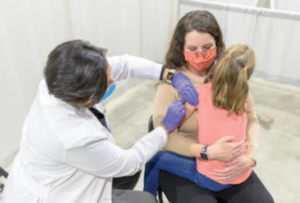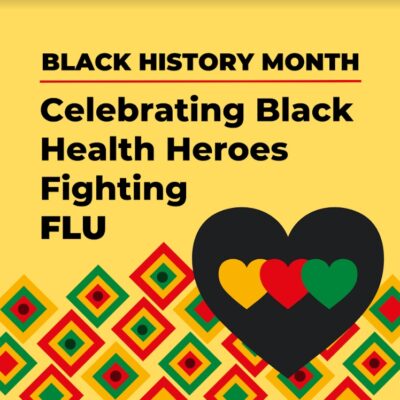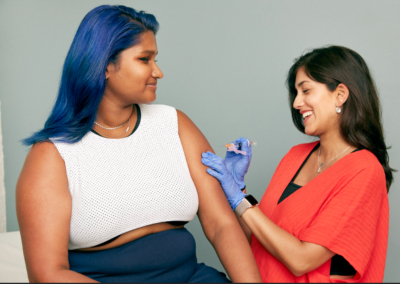- Expert Commentary
How To Comfort Kids During Vaccination

The following article is guest authored by Dr. Alexandria Yarborough, PharmD. She is a Pharmacy Manager in South Carolina and a Families Fighting Flu Advocate.
It’s very normal for children to express fear or anxiety over getting a shot. However, please don’t let this or other concerns prevent you from sticking to the recommended childhood vaccine schedule for your child. Vaccinations are a very important part of your child’s medical care. Here are ways that a parent can help a child overcome their fear and help them understand why vaccinations are so important:
1. Prepare them According to Age and Temperament
For young children (2-4 years old):
In this age range, it is usually best to tell them immediately before or during the visit. Say something simple in a positive tone: “You will get a shot today. They are little pokes that might hurt for a minute, but I will be here to help you to be brave. You need them to keep you healthy, so you don’t get sick.”
For children 4 years or older:
In this age range, they may benefit from a little more advanced preparation — maybe a day or two before. Explain that you are going to the pharmacy or doctor’s office and they are going to get a shot(s). For example, you might say: “Vaccine shots are special medicines that will help you to stay healthy. Everyone gets shots from babies to older adults. They sometimes hurt, but only for a short time. I will help you to be brave. You will be OK.”
Regardless of age:
The most important thing is that you don’t neglect to tell them in advance to avoid a negative reaction. This is a normal response, and your child is expressing a feeling. That’s okay! Fear of needles or vaccines is normal at any age. Allow your child to express their feelings even if they’re mad, sad, or tearful. They will be more open to your support if their feelings are being heard.
During the conversation, it’s important to remain calm. If you’re feeling anxious, your child will feel anxious.
Tip: Use kid-friendly language by choosing words like “vaccine” or “immunization” instead of “shot.” This is helpful because the word “shot” may have negative associations, either from past experiences or from confusion around the more violent definition of that word. You can also describe the feeling as a “pinch,” “pressure” or “small poke” instead of words like “sting” or “burn.” And, finally, refer to pharmacists and staff as “helpers” to make a connection that they’re there to help them receive their vaccine, not hurt them with a needle.
2. Practice the Steps
For younger children, let them play it out. Rehearse the vaccination through play by using a toy syringe on a stuffed animal. Reinforce the steps you talked about previously and then ask them what would make their stuffed animal feel better. This process helps your child feel more in control and it may be something you want to do several times before the appointment.
You may want to have them practice breathing (big slow breaths) and relaxing their arm muscles at home so that you can remind them that you practiced this, and they know what to do.
3. Ask How your Child Feels, and What They Already Know
Start your conversation with questions. Your child may not offer their thoughts or feelings without being prompted, and this gives you the chance to hear what your child may already know about the vaccine.
Then, most importantly, listen to what your child has to say without judgment. Don’t blow off statements like “needles are scary” or use phrases like, “It’s no big deal. You’ll be fine.” This may seem like you’re trying to reassure your child but, really, it may make your child think their feelings are wrong. Hear your child out and try responding by acknowledging these feelings.
Avoid bringing up the topic at a time where you may be cut short or if your child is hungry or tired. Timing can really matter in helping your child process this information so make sure you have the time and patience to hear your child’s feelings.
4. Inform your Child of the Details
Explain the entire process. For example, say “They may ask us to sit and wait. When it’s our turn, we’ll meet the pharmacist and she or he will show us where we can sit. Then, the helper will wash an area of your arm to make sure there are no germs. This may feel cold and the wipe might smell like hand sanitizer. Next, you’ll get your vaccine through a small poke – you may feel a little pressure or pinch, but it will be quick! Then, you’ll get a Band-Aid and it’s all done.”
5. Address Why you’re Getting the Vaccine
Be concise and keep it simple. Describe a vaccine as a superhero shield to protect us from sickness caused by germs. The vaccine will teach your body to fight against germs to keep you safe and healthy. It may be helpful to reference they’ve had these before so it doesn’t feel new and scary.
Tip: Talk about the vaccine in a positive way. Focus on how they’re doing something for the greater good. By keeping their body protected against COVID, they are also helping keep friends, family, teachers, and others in our community safe.
6. Distraction: Give your Child Something Else to Think About
During the actual time of vaccination, most children do best if they do not see the needle. Having them actively involved in some quiet activity can help keep their mind off the pain. Some ideas include singing a song, cuddling a stuffed animal, telling jokes, or looking at their favorite show on a screen.
Your child may also benefit from comfort positions to help them feel safe and more in control. Examples include: having them sit on your lap hugging you, having them sit with you side by side, sitting on your lap with their back to your chest, or in a side comfort hold.
 .
.  .
. 
7. Reward: Celebrate the milestone
The sting of the shots can be lessened somewhat by a reward, celebrating the completion of this important childhood milestone. Something that a child can share with their parents can be fun such as enjoying a food treat like ice cream or going to the park for the afternoon. When the shot is over, don’t forget to give your child lots of praise. This is something that felt hard to do and they did it. That should be celebrated.
Compliment them on the hug they gave you during the shot, or on staying still or doing great breathwork. By praising your child, you’re reinforcing the positive behaviors, and setting your child up for more success the next time they need a vaccine.
8. Oral Pain Medicine: Help Alleviate Soreness
A dose of ibuprofen (Advil) or acetaminophen (Tylenol) can help a child with some of the soreness (or fevers) they may experience AFTER their vaccinations. It is best not to pretreat your child with oral pain medication, as those medications may reduce the immune response from the vaccine. So again, the best timing for a dose of oral pain medication is usually a few hours after the shot, and the medication can be continued for up to 48 hours if needed. Please discuss the dosing of these medications with the doctor or pharmacist.
References
https://www.scripps.org/news_
https://www.hopkinsmedicine.
https://healthblog.uofmhealth.
https://www.cdc.gov/vaccines/


